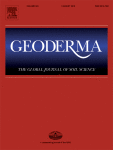Ver ítem
- xmlui.general.dspace_homeCentros Regionales y EEAsCentro Regional Buenos Aires SurEEA Cuenca del SaladoArtículos científicosxmlui.ArtifactBrowser.ItemViewer.trail
- Inicio
- Centros Regionales y EEAs
- Centro Regional Buenos Aires Sur
- EEA Cuenca del Salado
- Artículos científicos
- Ver ítem
Glyphosate dynamics in a soil under conventional and no-till systems during a soybean growing season
Resumen
Glyphosate (GLY) is a non-selective herbicide, heavily used world-wide in agriculture, especially under no-tillage (NT) management. The objectives of this work were i - to determine the temporal and vertical variation of GLY and its main metabolite (AMPA) levels during the soybean cycle in a soil under NT and conventional tillage (CT); ii - to determine the relationship of GLY and AMPA levels variation with different soil properties; and iii - to compare
[ver mas...]
Glyphosate (GLY) is a non-selective herbicide, heavily used world-wide in agriculture, especially under no-tillage (NT) management. The objectives of this work were i - to determine the temporal and vertical variation of GLY and its main metabolite (AMPA) levels during the soybean cycle in a soil under NT and conventional tillage (CT); ii - to determine the relationship of GLY and AMPA levels variation with different soil properties; and iii - to compare initial and final GLY and AMPA levels in the soil during a crop cycle to infer possible accumulation. GLY and AMPA contents were determined in the A horizon (0–40 cm) of a loam soil from Argentinian Pampas Region, in different dates during soybean crop cycle. Soil physical and chemical properties were also determined. GLY and AMPA were detected in all sampling dates in both treatments (GLY and AMPA contents in the soil ranged between 5.7 and 98.5 μg·kg−1; and 6.6 and 1686.0 μg·kg−1, respectively). GLY was strongly retained in the top soil in most of the sampling dates for both treatments (>80% of total GLY was found in the topsoil - 20 cm). CT treatment showed higher GLY temporal variation, favored by higher values of saturated hydraulic conductivity (K0), total macroporosity (θma) and effective macroporosity (εma), especially when strong precipitation occurred near the application. GLY vertical transport under NT seemed to be limited by low values of K0, θma, and εma. The temporal variation of GLY vertical transport was explained by the temporal variation of the studied soil physical and hydraulic properties. Total extracted GLY accumulated, with an increment between the last and the first sampling date of 54% and 82% during the crop cycle for NT and CT, respectively.
[Cerrar]

Autor
Soracco, Carlos Germán;
Villarreal, Rafael;
Lozano, Luis Alberto;
Vittori, Santiago;
Melani, Esteban;
Marino, Damian Jose Gabriel;
Fuente
Geoderma 323 : 13-21. (August 2018)
Fecha
2018-08-01
ISSN
0016-7061
Formato
pdf
Tipo de documento
artículo
Palabras Claves
Derechos de acceso
Restringido
 Excepto donde se diga explicitamente, este item se publica bajo la siguiente descripción: Creative Commons Attribution-NonCommercial-ShareAlike 2.5 Unported (CC BY-NC-SA 2.5)
Excepto donde se diga explicitamente, este item se publica bajo la siguiente descripción: Creative Commons Attribution-NonCommercial-ShareAlike 2.5 Unported (CC BY-NC-SA 2.5)

